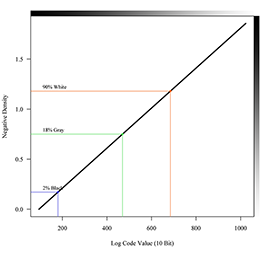A film recorder stands at the end of the digital post production. It brings digital images back to negative film, which is used to produce the release prints.
A CRT film recorder consists of a small cathode ray tube (see the next chapter), a color wheel with red, green, and blue filters and a camera. An image from the computer is sent to the monochrome CRT, which is photographed once through each of the color filters resulting in a full color image on film.
In CRT recorders mainly camera negative film is used for the recording because the CRT image is not bright enough to expose low speed intermediate film. If the recorded program originates from film, however, it will already contain grain from the camera negative that was used in shooting. The recording will add additional grain since the images are transferred to camera negative again. An additional problem is that it is not possible to produce the maximum density encoded in a DPX file, which is 2.046 log D.
A laser film recorder uses red, green, and blue lasers and a rotating mirror deflecting the light beam back and forth across the film frame. The lasers can output more energy than a CRT, which enables recording on intermediate film in the same speed a CRT recorder can expose the image on camera negative.
Intermediate film has a much finer grain than camera negative, as was already shown in Figure 2.3. Therefore, one can produce a sharper image on intermediate film and avoids building up additional grain.
Shooting on intermediate stock also allows the use of polyester-based film, which is incredibly tough and difficult to tear. As a result, release prints can be made directly from the original polyester based digital negative, providing first-generation quality. Rather than creating an IP and IN for release printing, many productions just make an IP for protection. This delivers significant cost savings when producing a limited release movie.
The most common image format used in DI is the Cineon/DPX format. As explained in the previous chapter, the DPX file is a linear encoding of negative densities. Therefore, it is only logical that the recorder transfers the DPX code values linearly into densities. Scanning from film and recording back to film should not alter the tonal characteristic of a scene.
To achieve this result both types of film recorders need to be calibrated regularly. This is usually done by recording a series of gray patches that vary from black to white onto negative film. The patch densities are read from the negative with a densitometer and the data is used to modify the intensity of the film recorder’s light source to achieve the target gray scale density. The aim for the recorder calibration is displayed in Figure 4.1.
The ARRILASER was introduced in 1999 and soon became the industry standard for film recording. It was the first film recorder that used solid state lasers. This achievement was recognized in 2001 by the Academy of Motion Picture Arts and Science with an Scientific and Engineering Award. The Academy stated: "The ARRI Laser film recorder demonstrates a high level of engineering resulting in a compact, user-friendly, low-maintenance device while at the same time maintaining outstanding speed, exposure ratings and image quality."
The ARRILASER has the following important features.
-
Supports 1920 (HDTV), 2048, and 4096 pixels per line.
-
Recording on intermediate film in 1.7 seconds per frame (with 2K).
-
Reproduction of the full dynamic range of DPX files (2.046 log D).
-
Low-maintenance solid state lasers.
Today, the ARRILASER is the only laser film recorder on the market.
-
Images originating from camera negative should be recorded on intermediate material to avoid additional grain.
-
A film recorder has to produce the same density range as an optically created internegative, which is usually 2.0 log D above base.
-
For highest quality the recording should be done with 4096 pixels per line.
